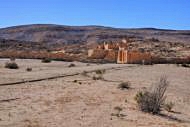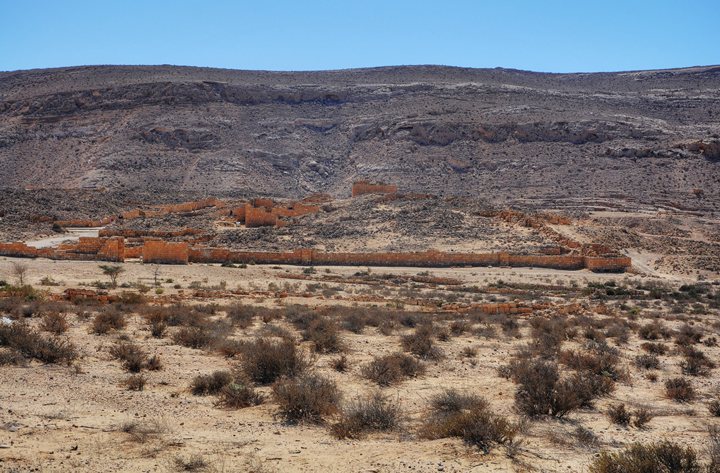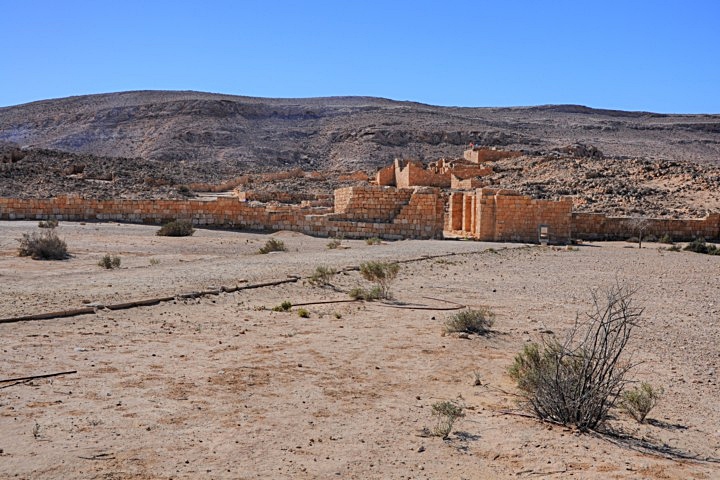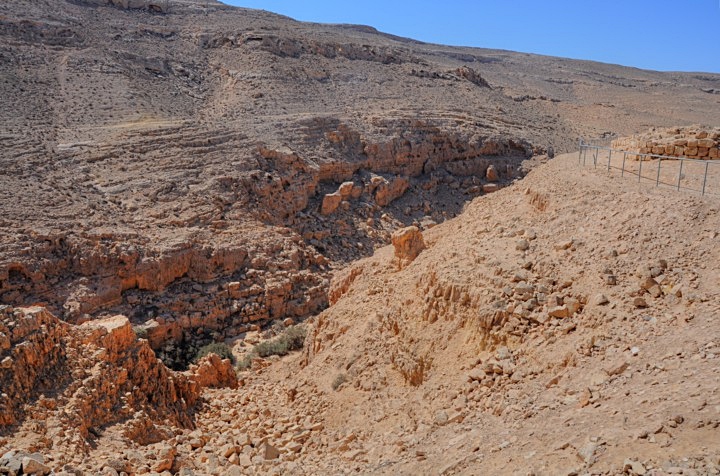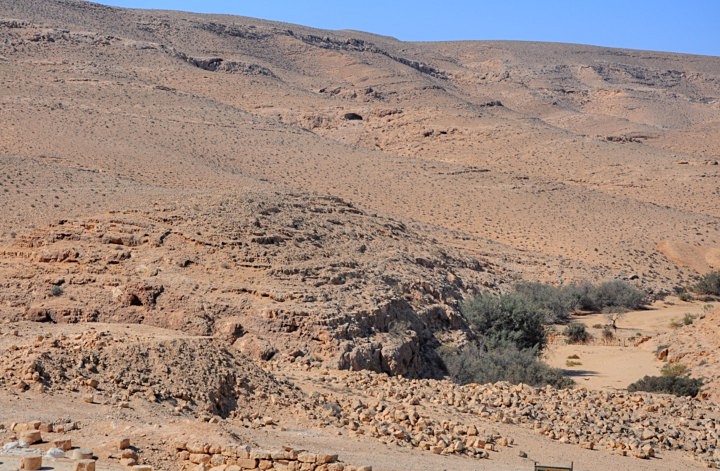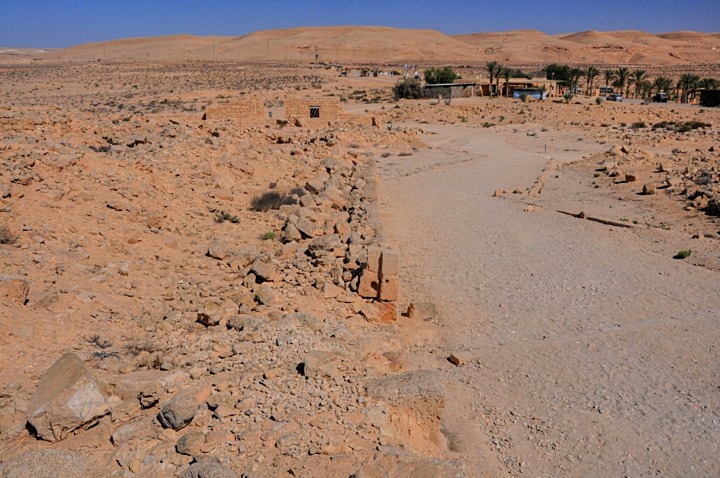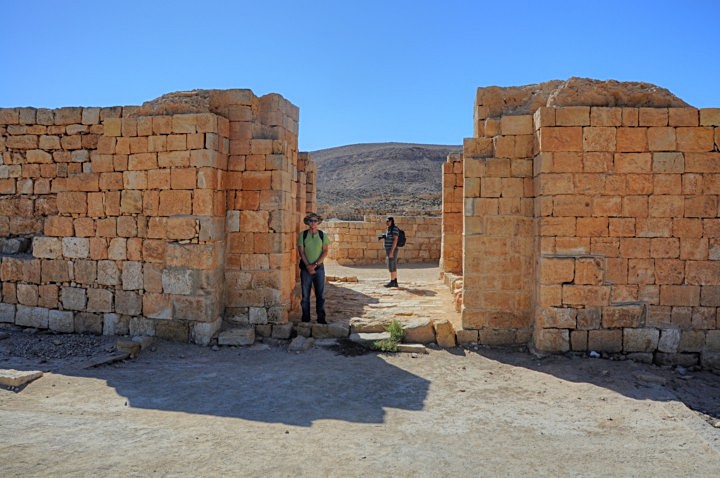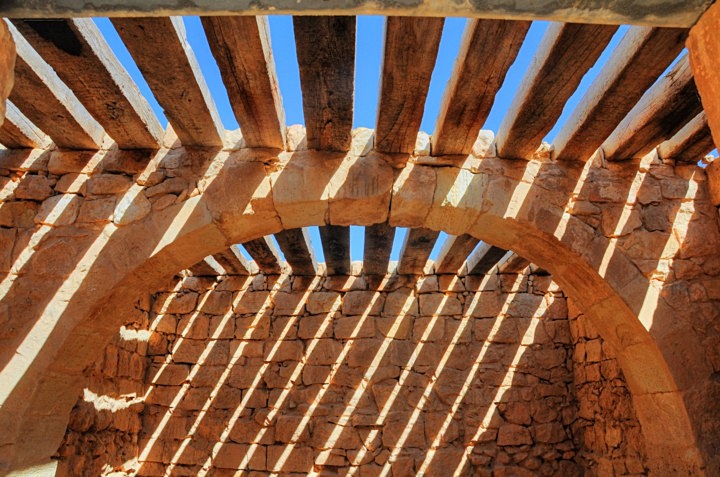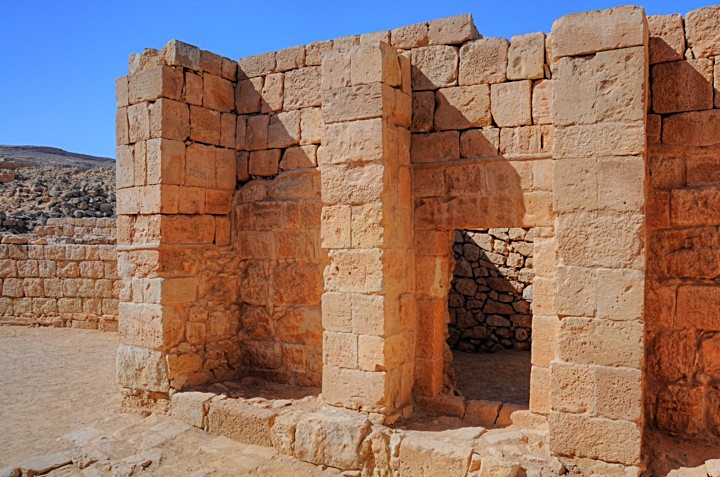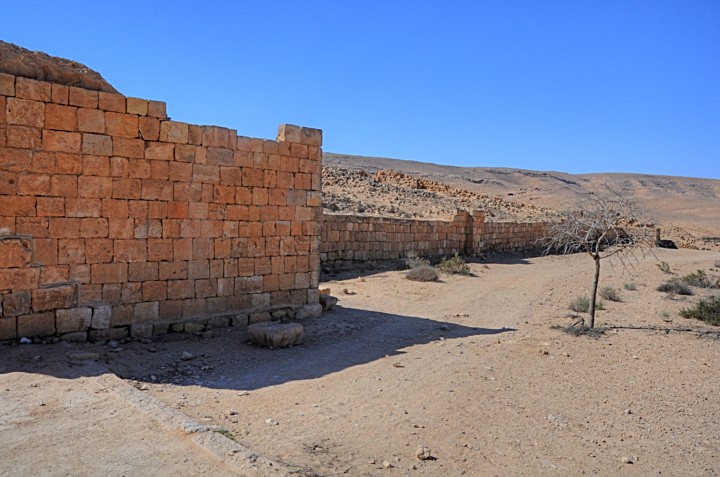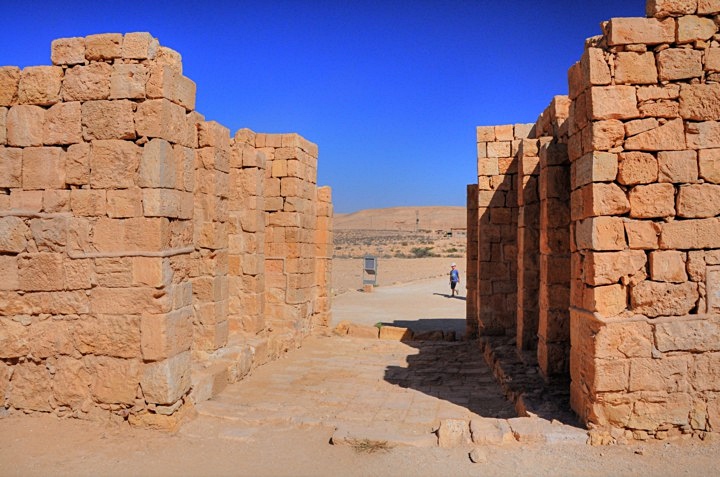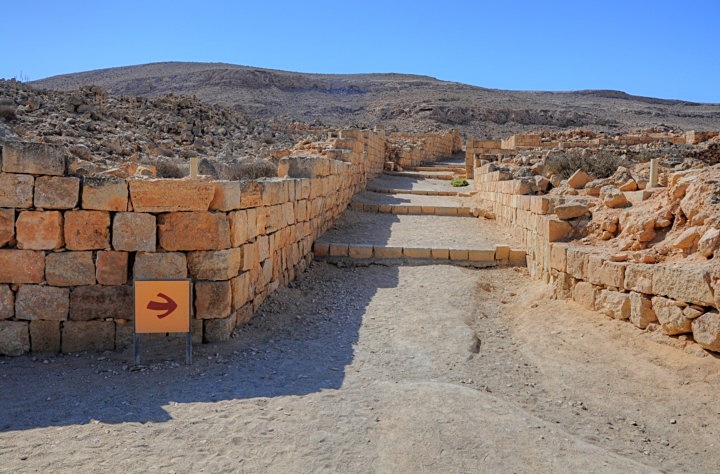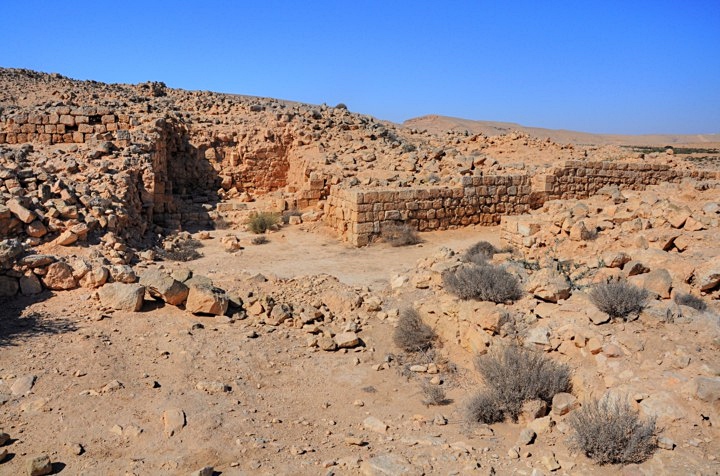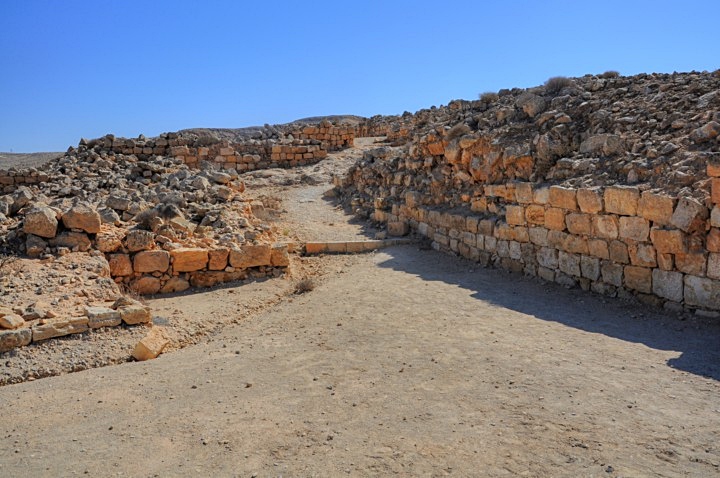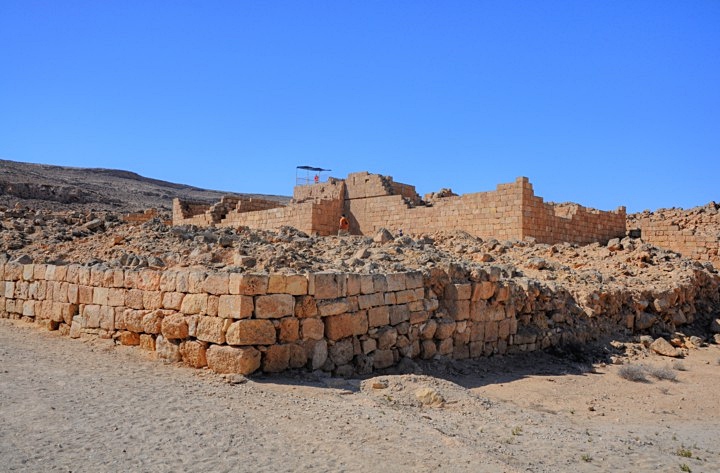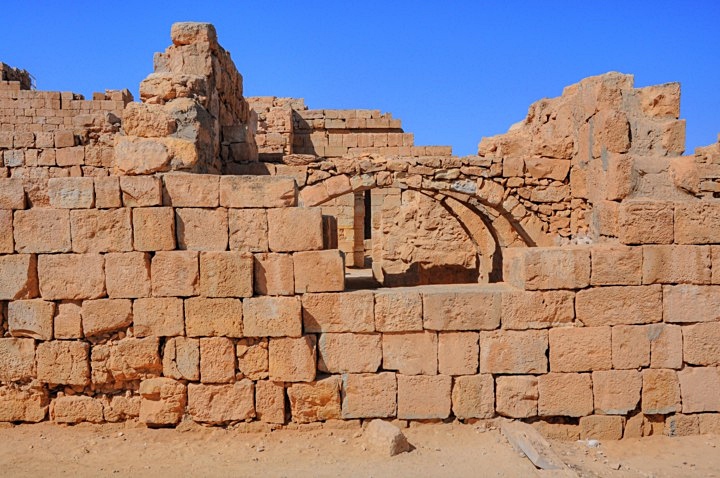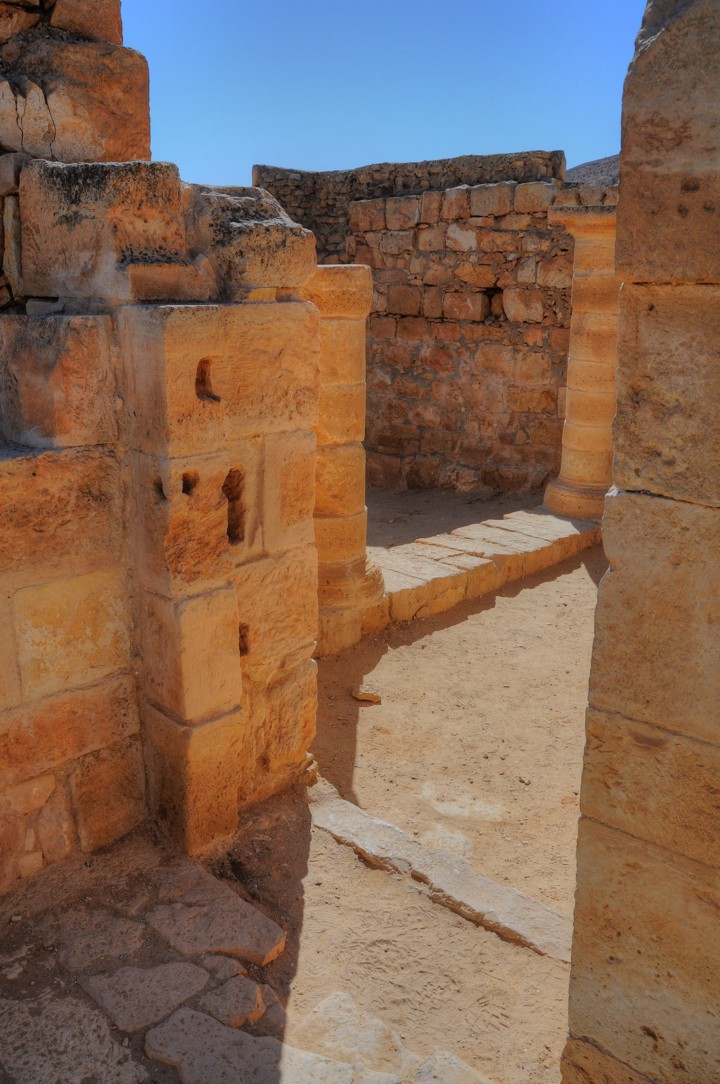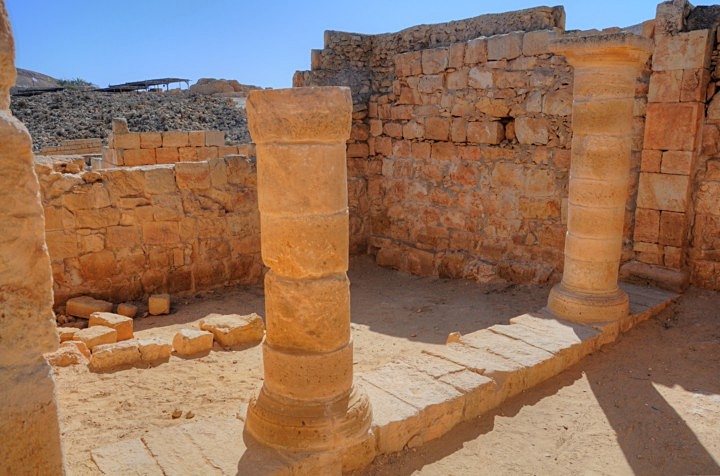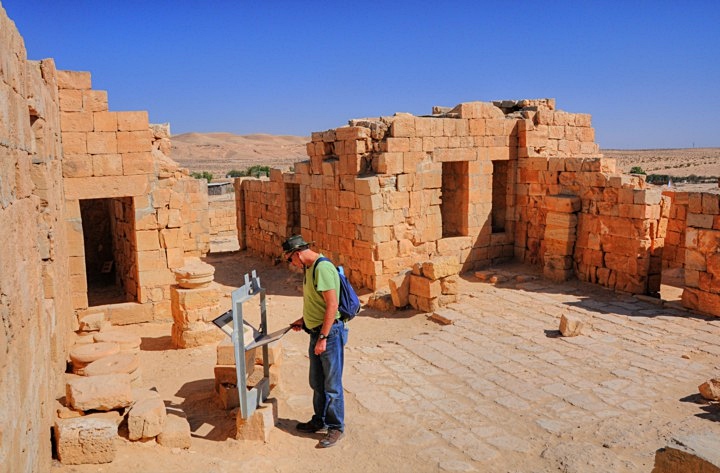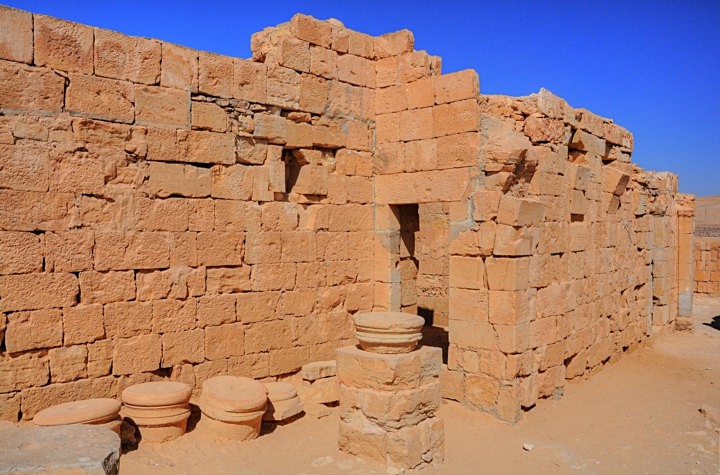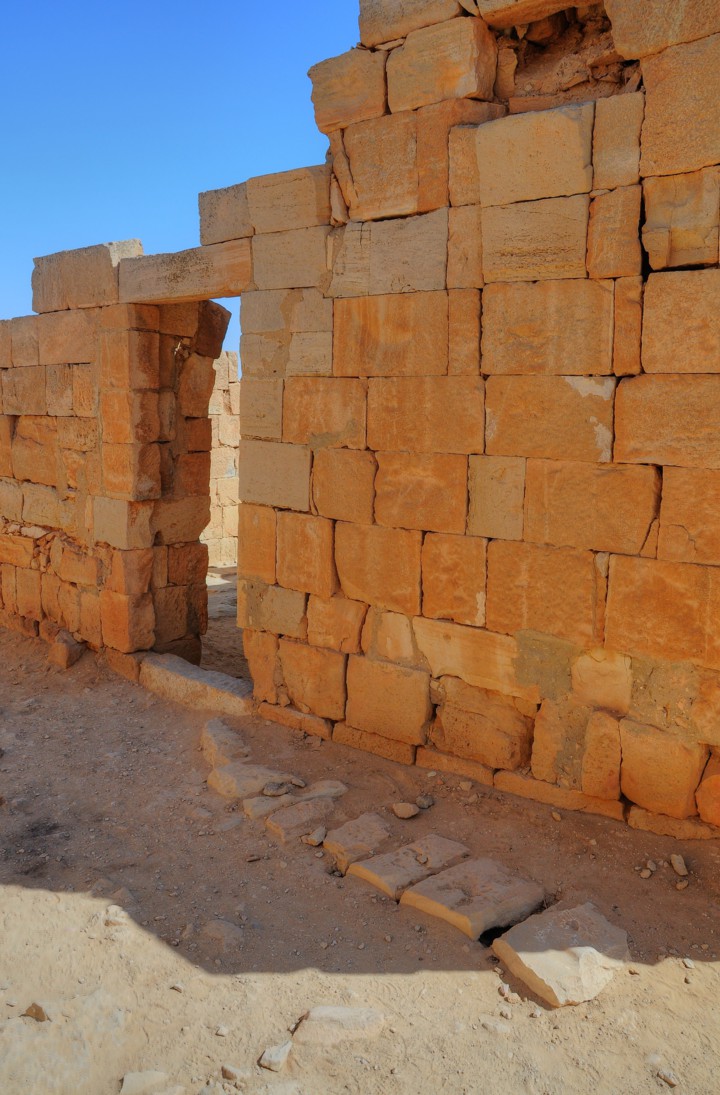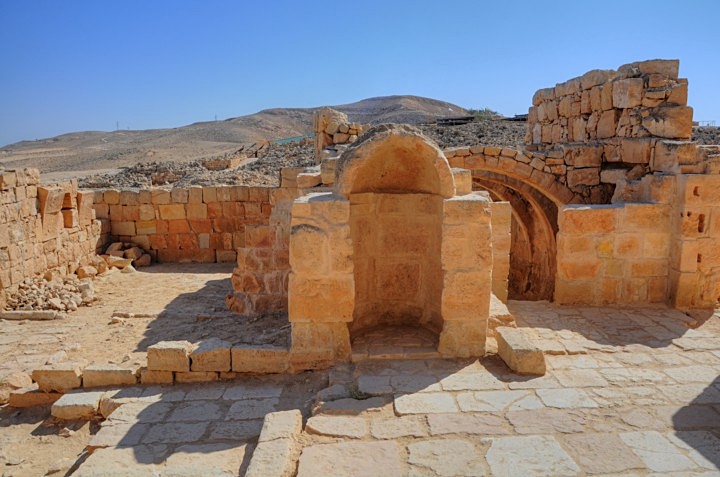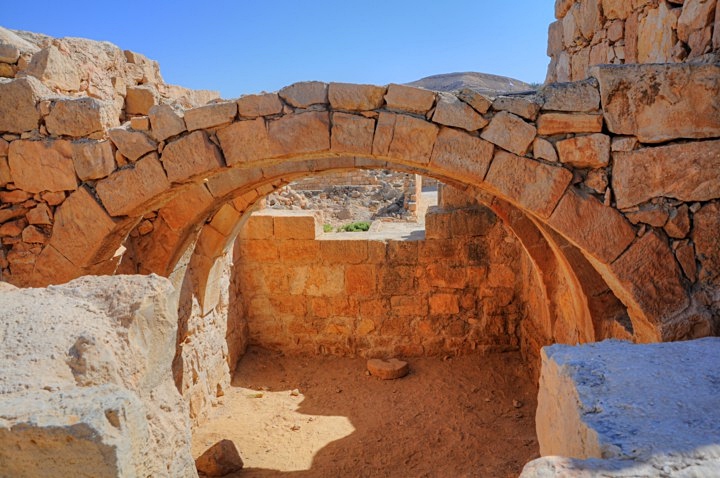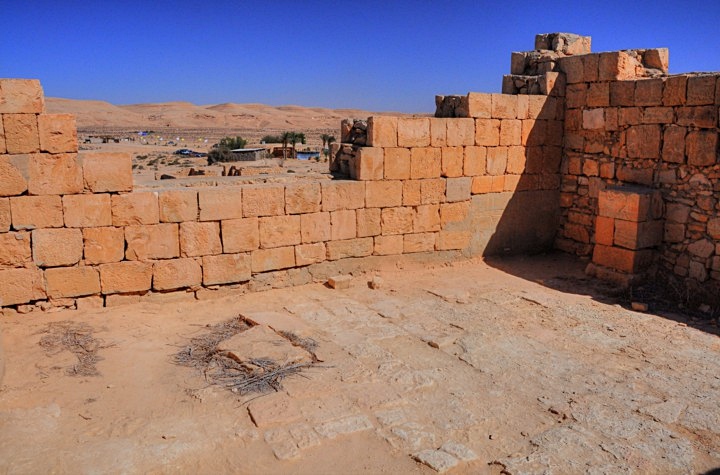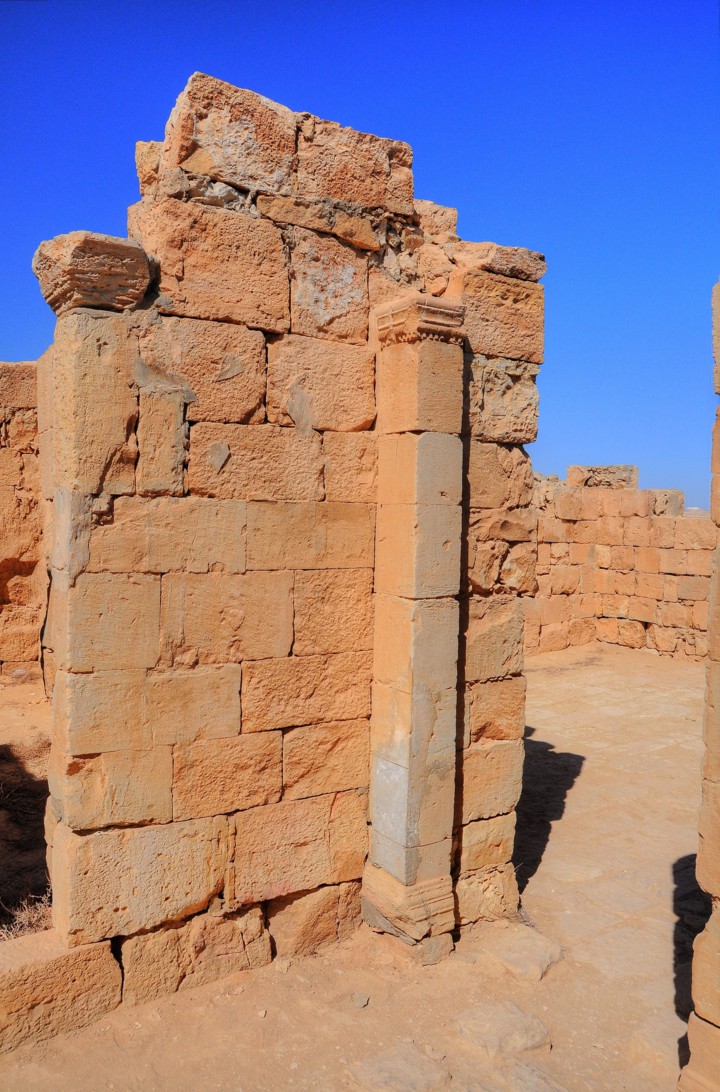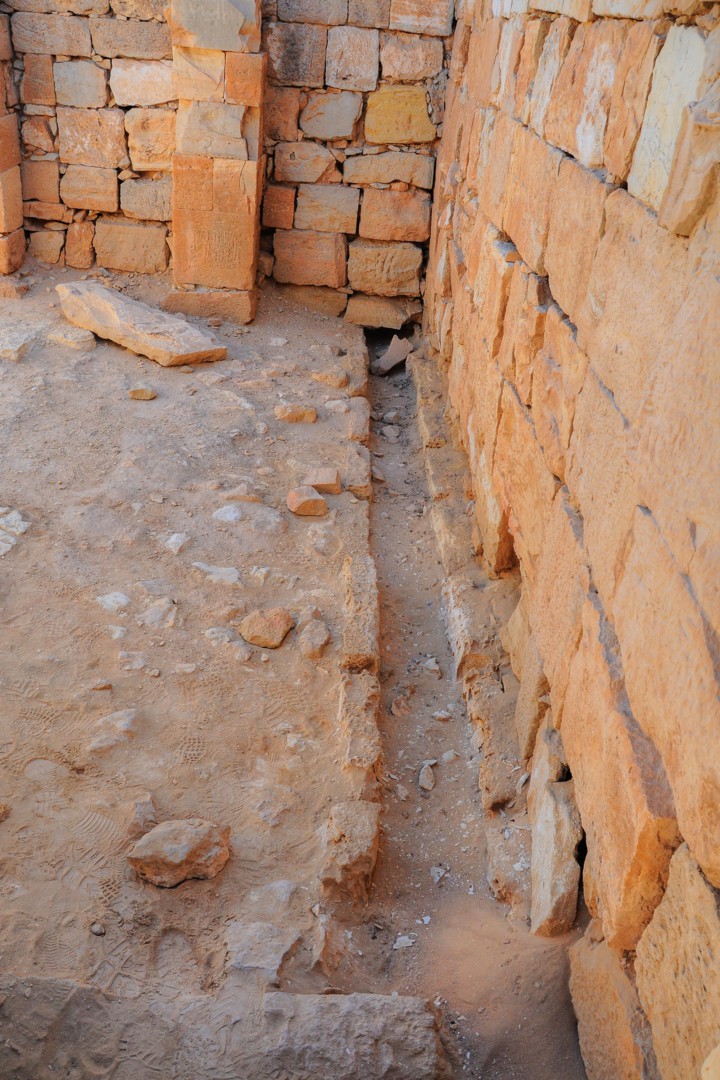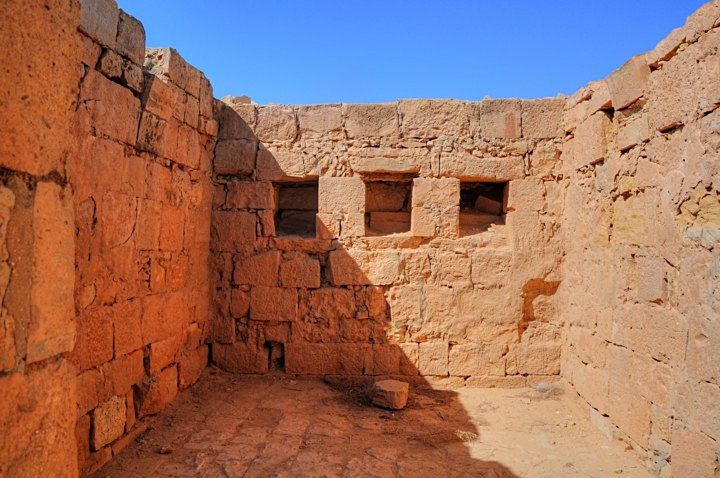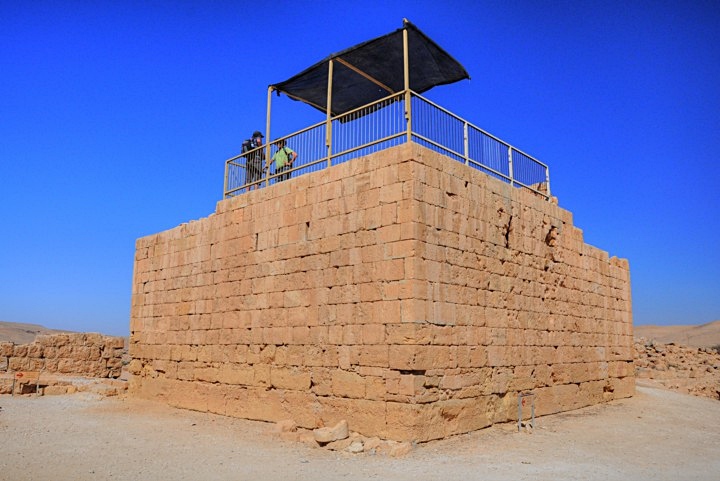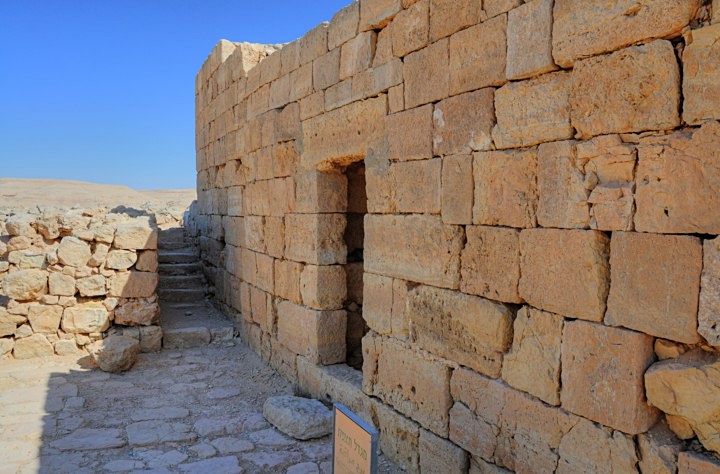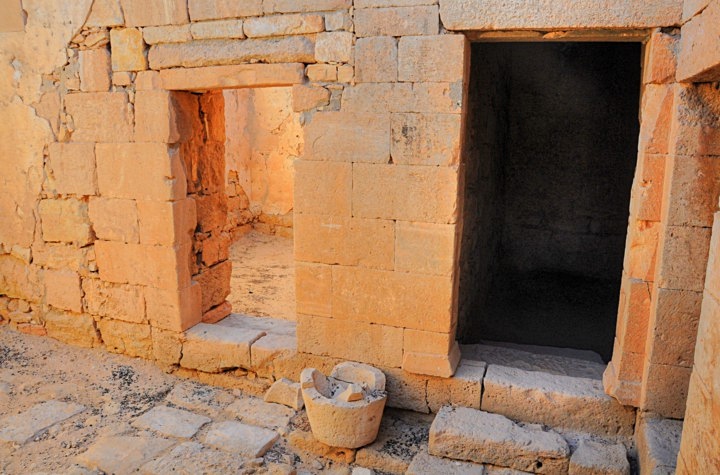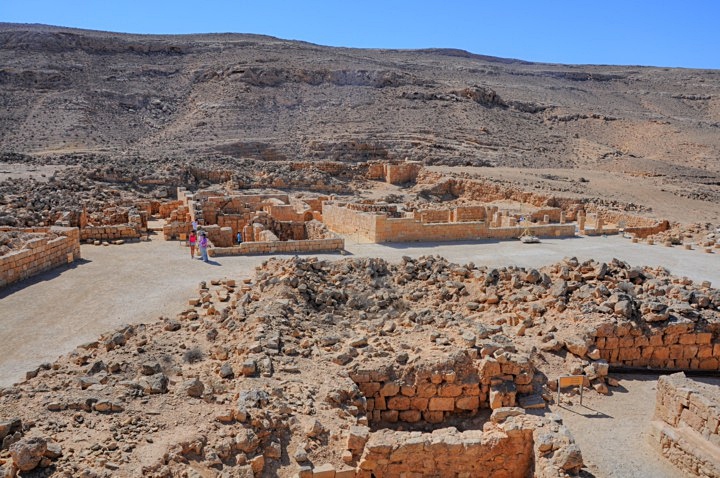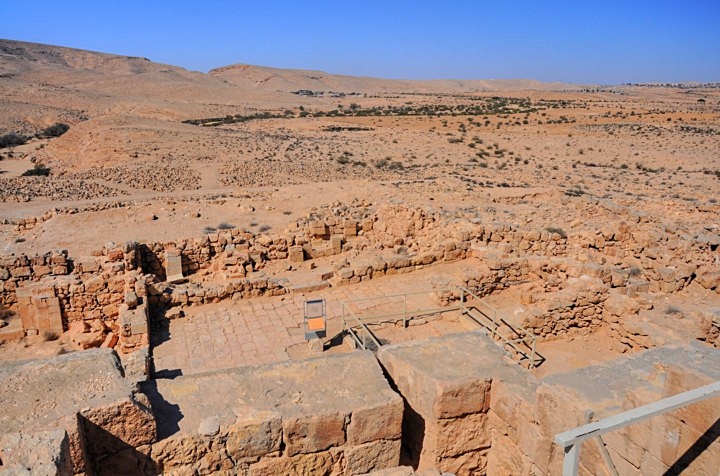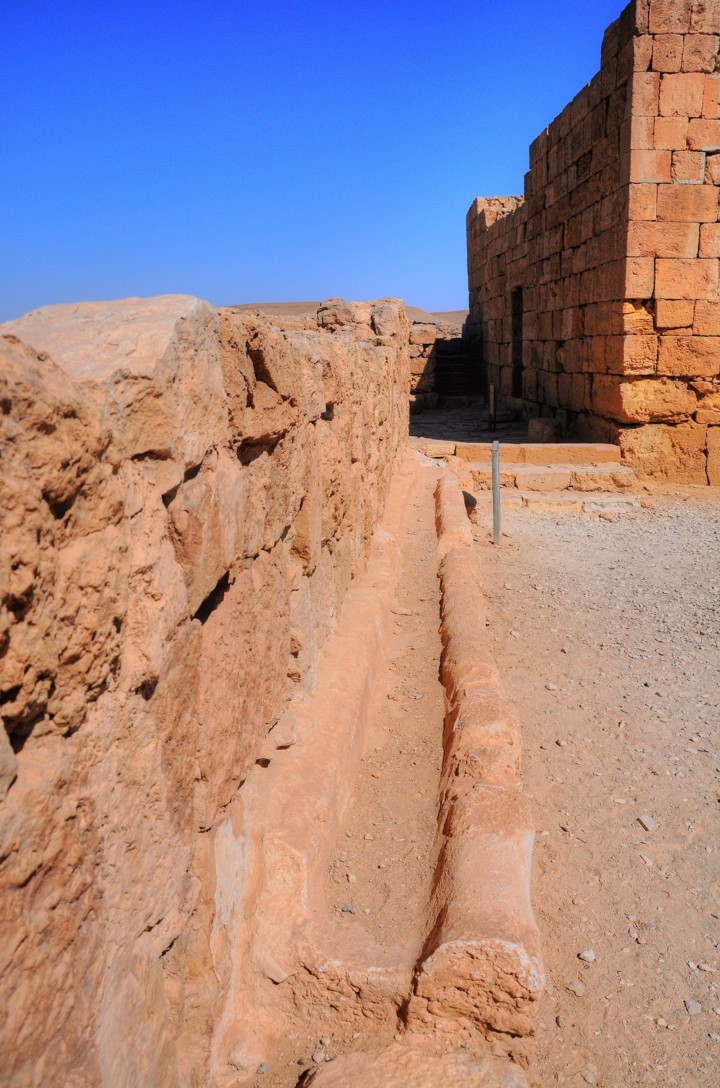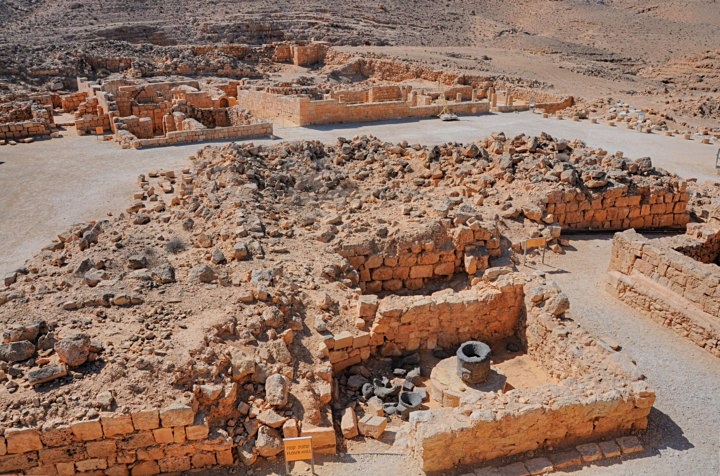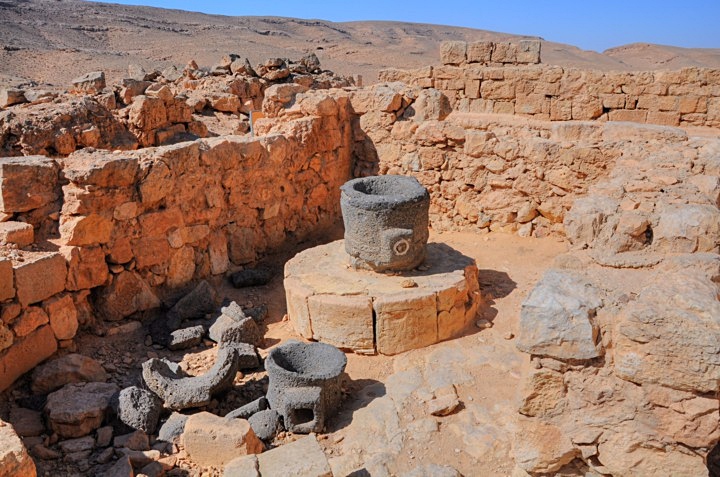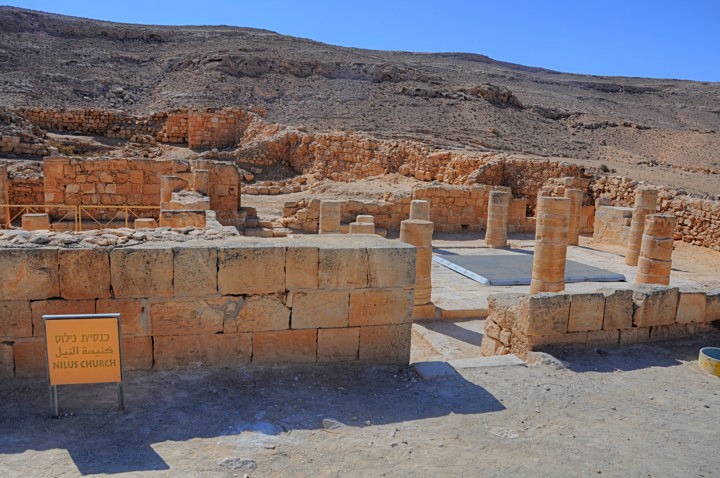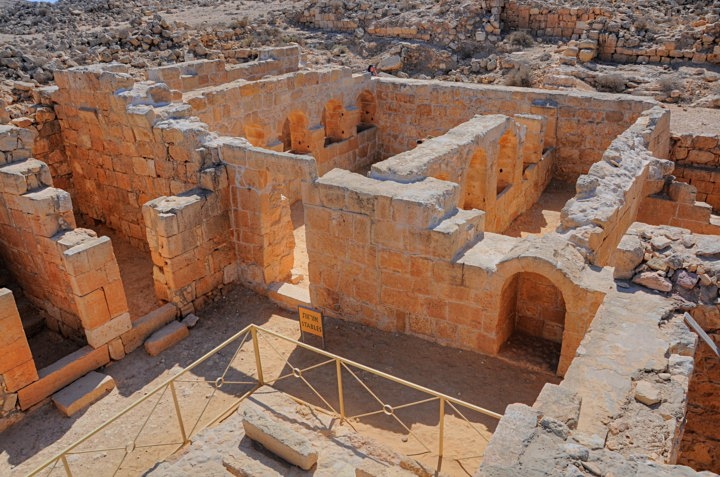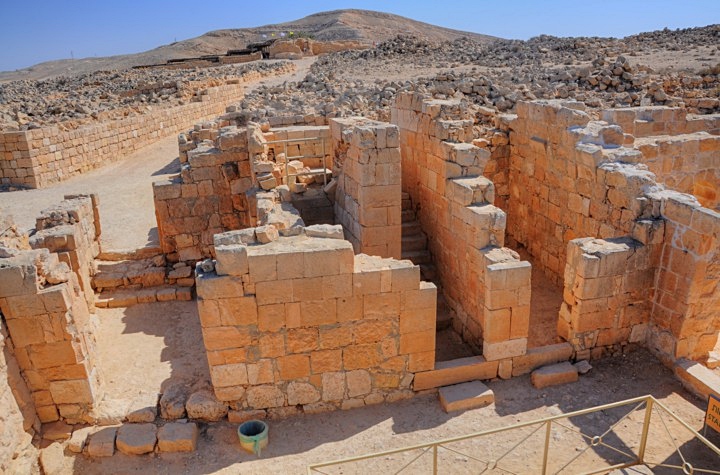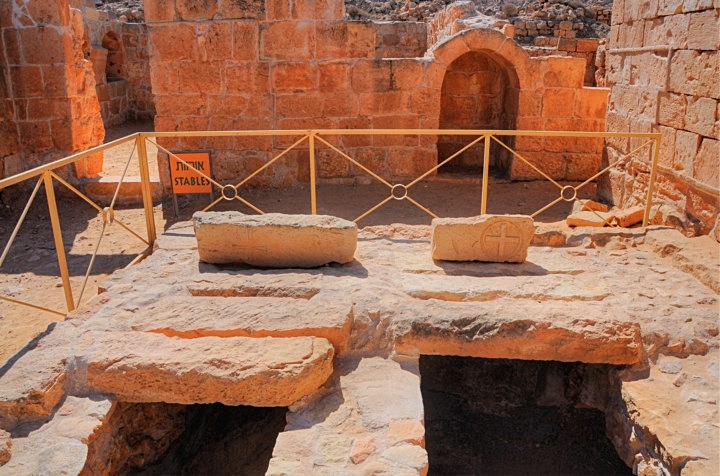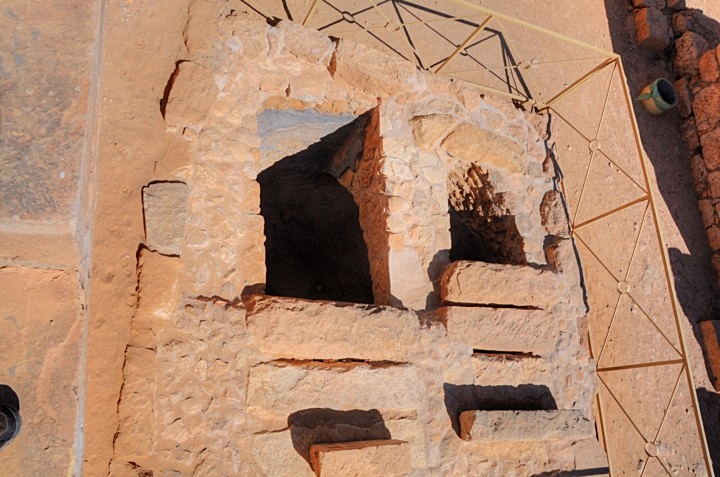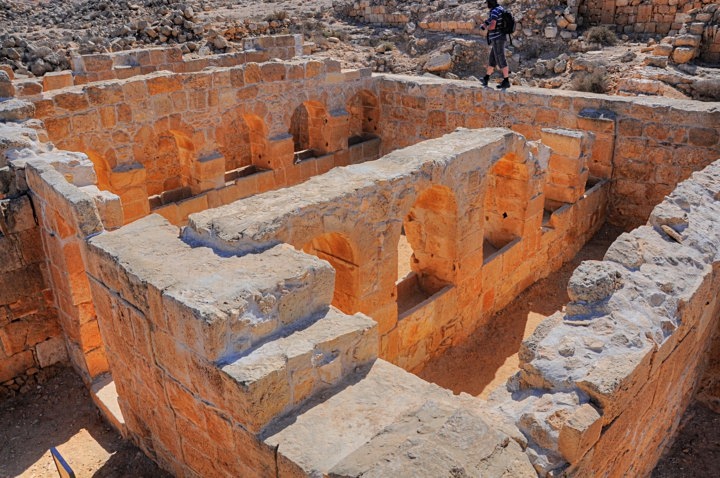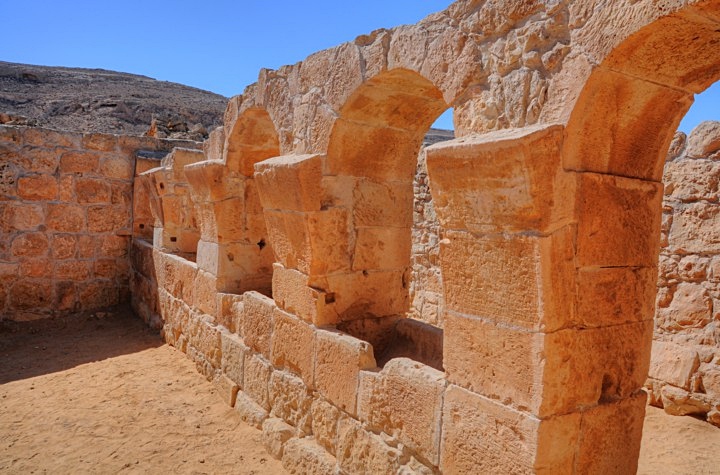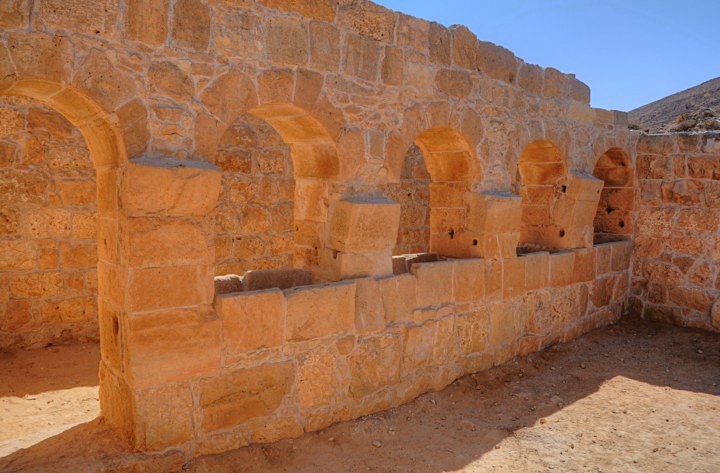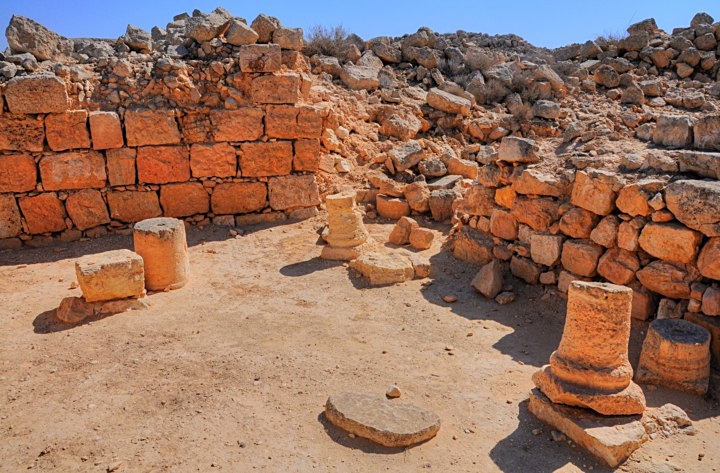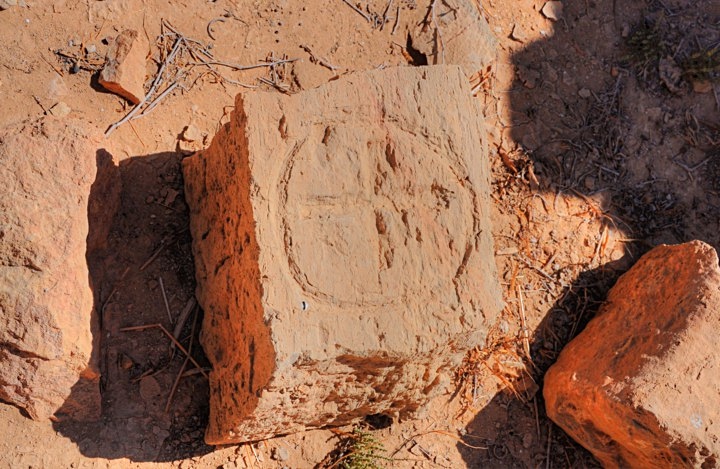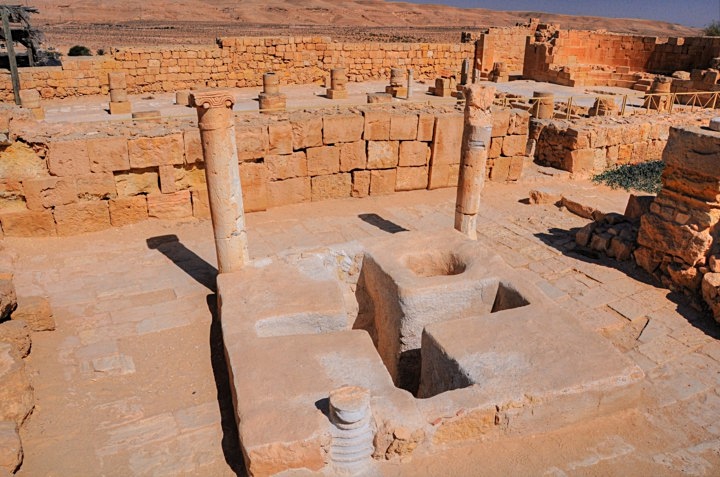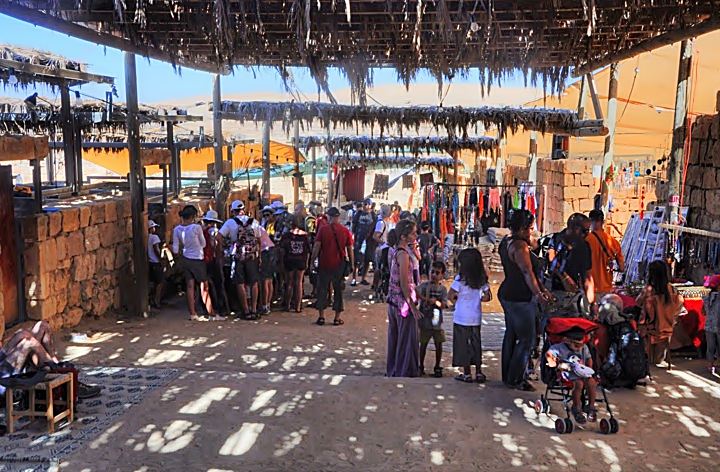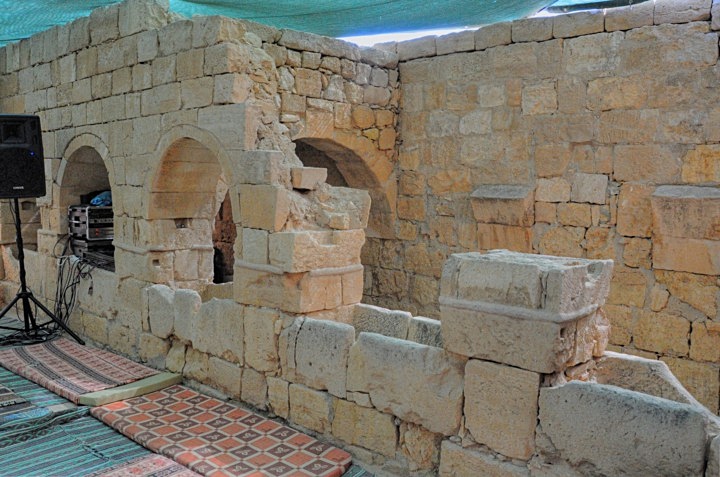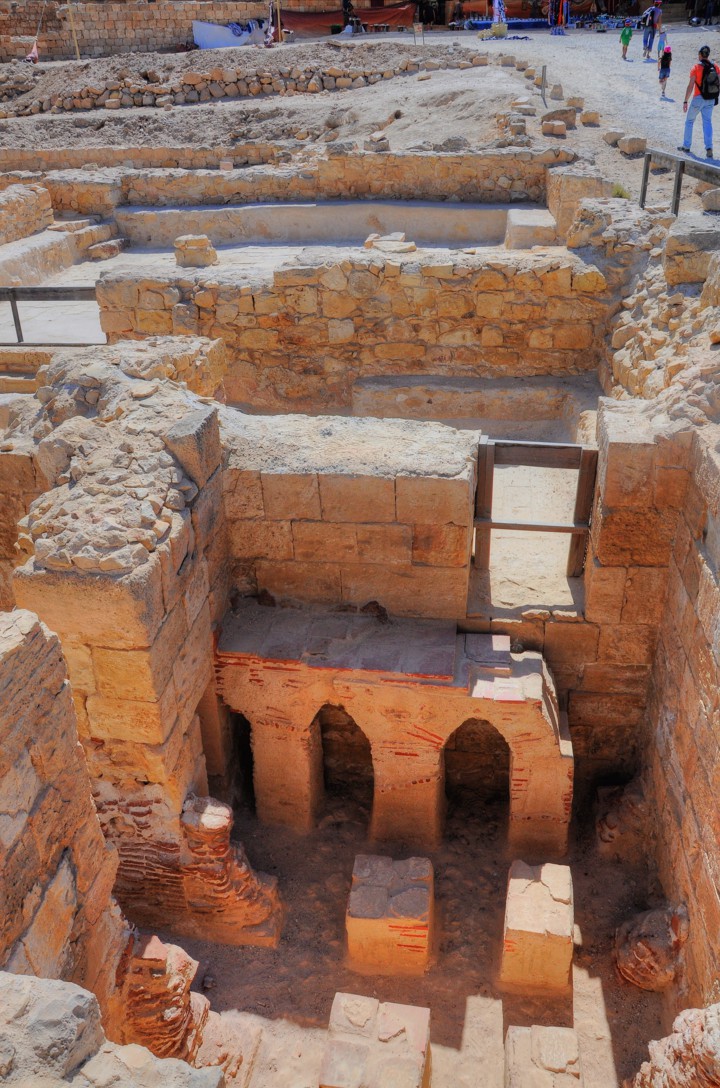An ancient Nabatean, Roman and Byzantine desert city situated along the Incense road.
* Site of the month Apr 2012 *
Home > Sites > Negev > Mamshit, Mampsis (Overview page)
Contents:
Background
Location
History
City Plan
Photos
* Aerial Views
* General views
* West side:
* Gate
* Inside the city
* Palace
* Western tower
* Western Yard
* Flour Mill
* Western Church
* Dwelling and stables
* East side:
* Eastern Church
* The Market
* Reservoir and bathhouse
Etymology
References
Links
Overview:
Mamshit (Mampsis) is an ancient Nabatean, Roman and Byzantine city, located southeast of Dimona. The city is situated on the Incense route, along the ancient road from Petra via the Scorpions Ascent towards the coastal plains and the mountains of Hebron.
This is an overview page. Due to the large number of photos and information, the site of Mamshit is covered in several web pages.
Location and aerial map:
The ruins of Mamshit are located 7KM east of the city of Dimona, in the eastern section of the Negev desert, at a height of 600m above sea level.
The aerial map shows the extent of the ruins, with the walled section covering an area of roughly 280m by 220m.
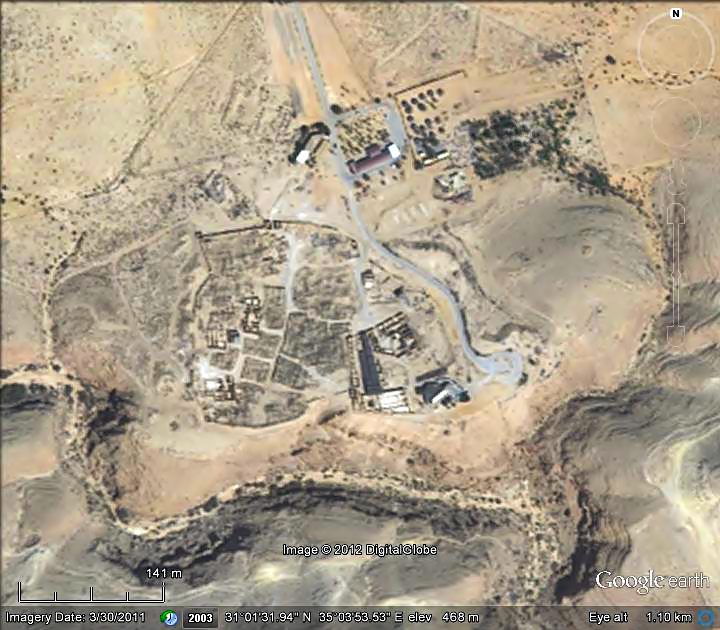
History:
Nabatean History: Read about the Nabateans in the Avdat page.
The city was first settled by the Nabateans during the mid-1st Century AD. This was one of the stations along the Nabatean trade route called the Incense & Spice route.
This route connected the east (Yemen and Oman), through Arabia, via the Nabatean capital city Petra, to the port cities on the shore of the Mediterranean Sea – Gaza, Raphia, Rhinocorura (al Arish). The road was used by the Nabateans to export the incense and spices from southern Arabia and the Far east to the Classic world of Greece and Rome. In order to support & protect the Incense route, the Nabateans established stations and fortresses along the road.

Illustration by DALL-E 2 – Caravans passing near a desert station
The Biblical map below shows the path of the Incense route, with the Nabatean cities marked by red stars. One of the routes passed through Mamshit, arriving from Tamara and the Scorpions Ascent, going north to Hebron and Jerusalem, or west through Beersheba to the port of Gaza. The other route passed through Moa, Avdat (Obobda), Shivta ,Nessana (Nitzana), Haluza (Elusa) and Rehovot.
Map of the ancient cities along the Incense/Spice route – during the Nabatean and Roman/Byzantine periods (based on Bible Mapper 3.0)
- Roman Period
Most of the buildings were constructed in the 2nd century AD after the Nabatean Kingdom was annexed by the Romans (106AD). It was the last Nabatean city built along the trade route.
At the end of the 3rd century the city was surrounded by walls. The gate was widened after the great earthquake of 363AD that shook the Holy Land.
- Byzantine period (4th – 7th century AD)
The Nabateans converted to Christianity. Two Churches and a monastery were built in Mamshit during the beginning of the 5th century.
The city was severely damaged after the Persian invasion (614) or the Arab conquest (636). Another theory suggests that the site was destroyed by a massive earthquake. This led to the abandonment of the city.
- Modern Period (20th century)
Mamshit was in ruins until the British mandate, when a police station was built on the south-eastern side of the ruined city. Large scale excavations began in 1965 by Professor A. Negev.
In 1966 the site was declared as a national park. The site became a UNESCO World heritage site in 2005, as part of the Incense route and the desert cities in the Negev.
Plan of the city:
The walled Roman city occupied an area of 40 Dunam (4 hectares), covering an area of roughly 280m by 220m. A plan of the city is shown below, with the major sites indicated as a yellow square. The city was built above the deep arid valley of Nahal Mamshit, which is located along the southern wall.
According to the estimates by Prof. Avraham Negev – the late leading scholar of Nabatean cities – the size of the houses was within a range between 500 m2 – 2,000 m2 , with an average size of 1000 m2 . Each house – a cluster of several rooms with two or three stories – was separated to neighboring structures with wide streets. These are considerably larger houses than the typical Roman house, and Prof. Negev finds that this design originates from the residents’ custom to live in spacious tents in the wide desert.
If the public areas are subtracted from the total area inside the walled city, then the conclusion was that Roman Mamshit had only 25 houses or so.
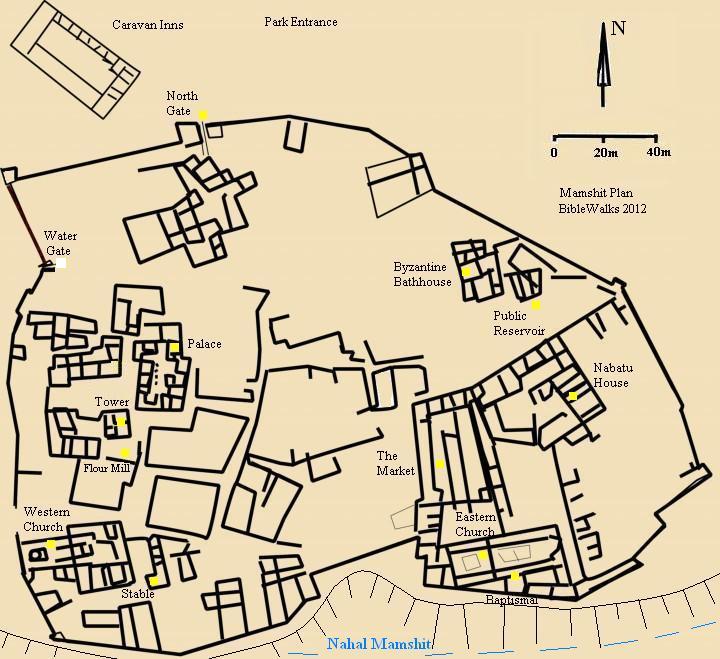
Photos:
(a) Aerial Views
A drone captured this view above the north side of the city. The walled Roman city covers an area of roughly 280m by 220m. Behind the southern walls is the deep arid valley of Nahal Mamshit. In front of the city gate, seen in the center, is one of the two large caravan inns.
Click on the photos to view in higher resolution…
A closer view of the city is in the following view:
On the north west side of the city are two large complexes – Roman period structures that served as caravan inns. This view shows the northern structure.
![]() The drone also captured this YouTube video above the north side of the city, and rotates around the area:
The drone also captured this YouTube video above the north side of the city, and rotates around the area:
(b) Ground Views
A north view of the ruins of the western side of Mamshit is seen here. The ruins of the city cover the foothills behind the walls.
A closer view of the walls , with the main gate in the center:
The deep valley of the stream of Mamshit (Wadi Kurnub) crosses the south side of the city. This view is from the southern side of the city, looking towards the east:
Another view of the valley, from the south-eastern side of the city:
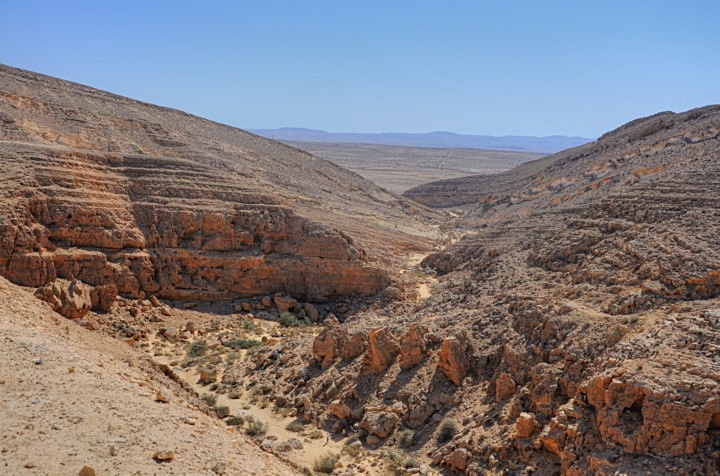
To the south-west of the city is a dam, which blocked the flow of the . This is one of the three Nabatean dams. They collected the water in the steam, creating lakes with a total of 10,000m3.
On the north side of the city is the visitors center, with a trail leading to the main gate.
The order of the sites of Mamshit below are presented in a “counter-clockwise” order, starting from the main gate on the west. Some of the sites are detailed in other web pages.
(c) West Side
A drone view of the west side of the city is shown in the photo below. It is taken from the north side of the gate, with a view towards the south.
The major points of interest are marked on the view:
The following sections provide details on the highlighted points of interest of the western side of Mamshit.
(d) Gate
The main gate to the city is located on the north side, as indicated as a red square on the right.

The gate was part of the Roman period wall (end of the 3rd century AD). It was widened after the 4th century earthquake.
An exterior view of the gate is seen below from the ground level, looking towards the south.
The gate was covered by a ceiling, which was supported by three arches. The eastern base of the structures is seen in the picture below.
The reconstructed room behind the eastern side of the gate shows how the Nabateans built their houses. Their houses were 2 or 3 level high, made of stone without cement. The advantage of such stone walls is that it keeps the house cold during the heat of the day, and warm during the cold desert nights. Arches were used to support the upper story. On top of the arches were stone slabs. This reconstruction used wood planks instead of stone slabs, but the original structure was made of stone since the Nabateans did not use wood as building materials.
The photo below shows the western side of the gate, with bases of the three supporting arches. On each side of the gate was a tower. The entrance to the western tower was through the guards’ room.
Note that the gate and the twin towers are illustrated as an icon on the 6th Century Madaba mosaic map found in the floor of a Byzantine Church in Jordan. Above the icon is the Greek word “MAMΨIC” (Mamfis), the Greek name of Mamshit/Mampsis. Between the towers is a church.
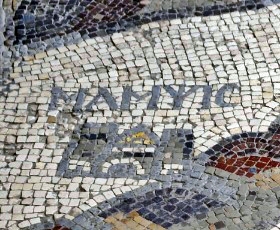
Part of Madaba Map
A view of the wall to the right of the gate is seen in the following picture.
The gate was burned and destroyed in the 7th century AD, destroyed during the Persian invasion (614) or the Arab conquest (636).
(e) Inside the city
Past the gate are traces of the ruins of the city. Some of the walls along the streets were reconstructed, and you can feel like walking through the Roman city.
Many of the structures are still in ruins, waiting for future reconstruction.
Another view of one of the streets and the ruins of the houses:
Walking up the hill, you approach the western section of the city. Here are two remarkable preserved structures – the palace (or wealthy house) and the tower (seen behind it). Pictures inside these structures are included in the following sections.
(f) “Palace” or Wealthy house
One of the best reconstructed house is a large building (1000 m2), which was named “the palace”. This was either the governor’s house, or the dwelling of a wealthy family.
The location of the “palace” is indicated on the map as a red square.
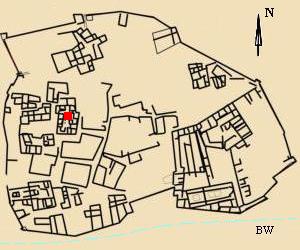
An eastern view of the building is seen in the picture below. It is built like a fortress, and was two stories high. The arches seen here supported the upper floor.
The following picture shows the entrance to the palace/ wealthy house, located on the south side. A small room on the right side of the picture served the guards who protected the entrance. The guardhouse was required since during the time of its construction the city was not yet protected by a wall. A number of small stairs lead down into the corridor.
- Reception Hall:
On the right side of the corridor is the entrance to the reception hall.
The front section of the reception hall was covered by a roof, with a pair of columns supporting the roof. The bases and capitols of these round columns are typical Nabatean. The rest of the hall was uncovered, and its entire floor was made of polished wood. The walls were plastered and probably painted.
- Courtyard:
The corridor leads to a long rectangular courtyard, surrounded by rooms. The two spacious rooms on the right side of the courtyard served the servants, and were not paved as in the landlord living rooms on the far rear side of the corridor. Two openings on the right wall served as a pantry, where the dry meat, fish, cheese and fruits and vegetables were stored.
The left (western) side of the courtyard is seen in the following picture. The bases and capitols of the columns are arranged on the floor, and once supported the floor of the balcony above the courtyard. The second floor was the main residential area, and was accessed through the staircase leading to the balcony.
Two storage rooms are accessed from the door by a small staircase. These rooms stored grain and flour in sacks, and oil and wine in jars.
Another room is located on the right side of the courtyard. Notice the covered water channel on the floor.
- Household water supply:
Two cisterns outside the house stored water for the house. The water was fetched into a large jar which stood in the middle of the courtyard, inside a round installation with a half-dome cape. A stove was located on the left side.
- Archive room:
Behind the household water jar is a small room. It served as the documents archive and library, used perhaps to keep the local horse genealogy documents and other documents. Several steps lead down from the courtyard down into the archive room, seen here under the supporting arches. A large niche in the entrance held a torch for illuminating the room. Inside one of the walls are grooves that once supported a wooden closet with these documents.
- Living Room
The rear (north) side of the house has a great view of the park. This is one of the residential rooms of the landlord and his wife. The living room is separated from the public section of the house.
The capitols and the bases of the doorpost leading to the living rooms are decorated. The floor of the rooms are paved.
- Interior details
Under the floor of the rooms are water channels, which led the water from the roof into the water reservoir. The lack of rainfall in this dry region forced the city builders to lay out these extensive networks of channels in order to collect the rain water for their water supply.
Niches in the walls used for storage:
- Access to upper floors
On the south-western side of the courtyard was the entrance to the tower-staircase, three stories high. The steps led to the second story of the house, then continued to the top of the tower. On the second floor was a balcony which was supported on the columns seen on the western side of the courtyard. This balcony opened to the living rooms on the second floor.
(g) Western Tower
A square tower, originally three stories high, is located near the wealthy house. This late Nabatean structure is square, 10 by 10m, and 5 meters high. This was a public structure which served the local police, guards and the administration. Its location is indicated on the map as a red square.
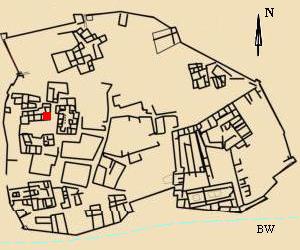
From the tower is a great view of the city (check the panoramic viewer at the bottom of this page).
The entrance to the rooms under the tower is located on the western side, as seen below.
In front of the entrance to the tower is a paved yard. Under its pavement was a rock-hewn cistern.
Inside the tower are several rooms and a staircase.
The following photo shows a southern view from the tower towards the hills above the valley of the Mamshit stream. You can tour the entire 360 degrees views in our panoramic viewer.
(h) Western Yard
The picture shows a western view from the tower – the side of the entrance to the tower. A paved yard can be seen in the center of the photo, with traces of structures around it, and a large cistern in its center. A set of rooms and a stove were located on the edges of the yard. They probably served the visitors to the city.
On the western side of the yard are two long storerooms supported by arches (you can see them at the far end of the pavement). The yard served as an unloading place for merchandise brought into the city, and the pack animals were tied to the arches of the storerooms. A raised platform above the adjacent street enabled the unload/upload of the loads from/to the animals.
A water channel is located on the wall near the entrance to the tower. The water was brought from the lake, then emptied into this channel. It lead the water into the cistern which is located under the pavement outside the tower.
(i) Flour Mill
The flour mill is located to the south of the tower. It is seen in the bottom of the picture. In the background, past the ruins of another structure, is the Western church and the stable.
The following picture shows the remains of the flour mill, with two complete upper millstones and additional basalt fragments. This type of mill is called “Pompeian” (or: Donkey mill). The mill also included a lower millstone base which is missing. The process of the grinding was as follows: the wheat grain was placed into the top hole, then the upper millstone was turned around the base. The grains would then be grinded between the stones, and the grounded grains would fall to the bottom.
(j) Western Church
The Western church (a.k.a. “Nilus” Church) is located on the south-western corner of the city. Its location is indicated on the map as a red square.
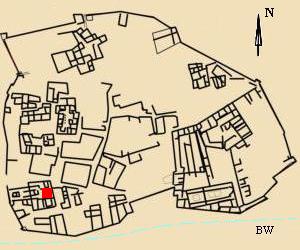
![]() For more information and photos of the church, see a separate page on the Churches of Mamshit.
For more information and photos of the church, see a separate page on the Churches of Mamshit.
(k) Dwelling and Stables
A Nabatean dwelling and a stable is located on the south-western corner of the city, adjacent to the Western Church. It is dated to 100AD and was in use until the 7th century.
Its location is indicated on the map as a red square.
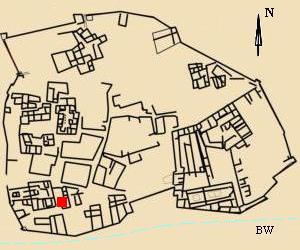
A view of the house, the stable and courtyard is seen in the photograph below, as captured from the wall of the church. Part of the Nabatean house was destroyed by the Byzantine church.
A closer view of the Nabatean house is shown in the next photo. This square structure was one of the smallest houses, occupying an area of 700m2. On the north side were several living rooms and on the south side was a staircase tower which leads to the second story.
- Courtyard and cistern:
A covered cistern is located in the courtyard in front of the house.
A top view of the cistern, shown below, is seen from the wall of the church. Notice how the cistern is covered with the stone slabs.
Two stone fragments with Christian cross carvings are located above the paved cistern. One of them is shown here.
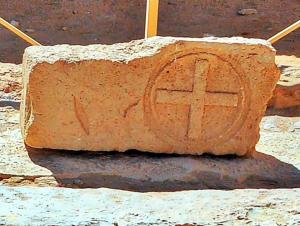
- Stable:
On the southern side of the house are the well preserved ruins of a stable. It contained a space for up to 16 horses, arranged as two wings. Mamshit had two stables.
Another larger stable is located on the eastern side. Arabian horse raising was one of the important sources of income in the Nabatean society.
A closer view of the stable:
In front of each horse was a curved window and a feeding trough. These beautifully designed troughs are based on limestone blocks. Holes in the posts also held horse tie rings. Other holes in the sides of the trough held an iron grille which limited the amount of grain the horse will eat, since is not healthy for a horse to consume large amounts of concentrated grain.
The bases of the four arches are seen on the side of the troughs. They supported, as in all of the Nabatean structures, the stone roof. Between the two sections of the stable is a curved entrance.
A nearby room served as a chapel. This room, half covered by a roof and half unroofed, was part of the Western church’s rooms. On its second floor was an incense altar.
One of the stones in this room has a carving in the shape of a cross:
(l) East side
A drone view of the eastern side of the city is shown in this photo.
The major points of interest are marked on the view:
The following sections provide details on the highlighted points of interest of the eastern side of Mamshit.
(m) Eastern Church
On the south-eastern side of the city is the “Church of the Martyrs”, part of a Byzantine monastery. It is named after the martyrs who were buried in boxes in the rooms that flanked the apse.
Its location is indicated on the map as a red square.
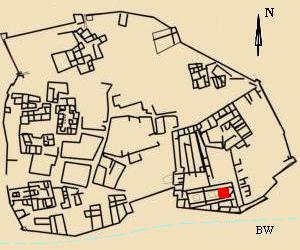
A ground view of the church and the baptismal chamber is shown below.
![]() For more information and photos of the church, see a separate page on the Churches of Mamshit.
For more information and photos of the church, see a separate page on the Churches of Mamshit.
(n) The Market
On the south-eastern side of the city, north of the church, is a street from the days of the Nabateans. Rows of rooms on the sides of the street served as shops. Its location is indicated on the map as a red square.
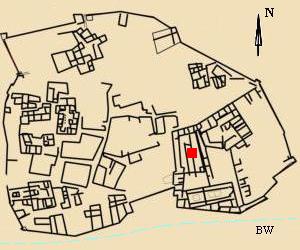
The market turns into a colorful and lively market during the Holidays. A view of the market during a festival is shown below.
![]() For more information and photos, see a separate page on the market.
For more information and photos, see a separate page on the market.
(o) Nabatu House – the largest house
On the eastern side of the city, north of the church, are the remains of the largest house in Mamshit.
Its location is indicated on the map as a red square. One of the rooms is shown below. This was a large stable, and was used for staging performances during the holiday festival.
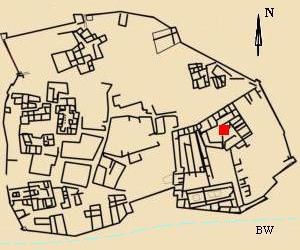
![]() For more information and photos, see a separate page of the house in the page of the market.
For more information and photos, see a separate page of the house in the page of the market.
(p) Reservoir and Bathhouse
On the north-eastern side of the city is a Byzantine bathhouse and a public reservoir. The location of the bathhouse is indicated on the map as a red square.
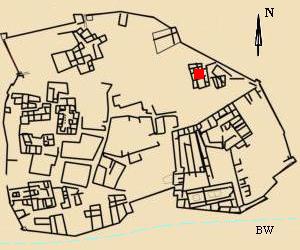
The red bricks of the heating system are seen in the picture below.
![]() For more information and photos, see a separate page of the waterworks in Mamshit.
For more information and photos, see a separate page of the waterworks in Mamshit.
Etymology (behind the name):
- Mamshit – unknown source of the name.
- Mampsis – Greek name of the city.
- Kurnub – Arabic name of Mamshit. Means: drink of milk, honey and dates.
References:
- “Masters of the desert” – Avraham Negev [Keter 533190; 1983] –
Describes the findings of Mamshit and Nabatean history.
Links:
* External links:
- Mamshit – A. Negev (Hebrew)
- A. Negev – Scholar of the Nabateans in the Negev (pdf)
* Other Nabateans sites:
- Avdat, Shivta and Nitzana – Nabatean/Roman/Byzantine cities
- Ma’ale Akrabbim, Hazeva – Nabatean stations to the east of Mamshit
- Moa – Nabatean/Roman station in the Arava
* Other info pages:
- The Nabateans – history, sites, map
- Earthquakes in the Holy Land
- Drone Aerial views – collection of Biblical sites from the air
* Mamshit sites:
Overview (this page), Mamshit Churches, Market and Nabatu house, Mamshit Water
BibleWalks.com – Ancient wonders in the Negev desert
Nitzana Cave<—previous site—<<<All Sites>>>—next Negev site—> Mamshit Churches
This page was last updated on Mar 22, 2024 (remove pano)
Sponsored links:
